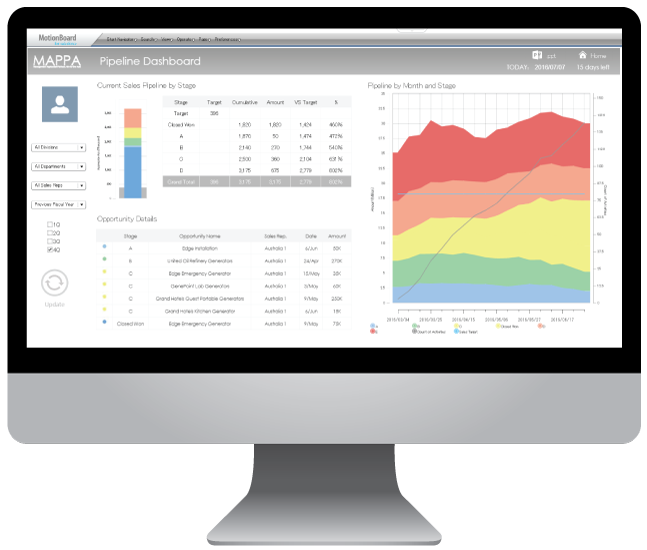Making informed decisions relies heavily upon understanding the in’s and out’s of business. When used properly, the most powerful tool we have to understand our business for financial planning and management is the data generated by the business. The data can tell you where the business is most efficient (its strengths) and where it needs improvements. Exploring the trends in financial data is necessary to improve any organisation’s performance, but not all people have the expertise to analyse the data to understand what’s going on. The data merely presents the numbers; it doesn’t necessarily tell you “the story”.
The story is often locked within the data and it usually takes a data scientist to draw it out. However, there are new tools available that help you to discover your organisation’s story. These tools, known as Business intelligence, or BI, tools are able to highlight the trends through visualisations.
The benefits of using BI tools cannot be understated. These tools enable you to unlock the secrets of financial data and improve planning and decision making. The Finance department is in a unique position to drive strategy because it gathers data from all lines of the business. Finance departments can employ BI tools to correlate financial outcomes with business activities and lead the organization toward its strategic objectives.
How Can BI Tools Help?
By focusing more on analysis and less on collecting and reporting, the Finance department can steer other departments in their decision making process to achieve better outcomes.
Your BI tool should provide a real-time flow of information in order to understand how better to:
- Reduce costs
- Increase sales
- Raise profitability
- Know when to purchase new capital assets
What important features are needed for your BI to help you achieve these goals? The top three features should be Forecasting, Analysis and Visualisation.
Forecasting
This feature is imperative for drawing up a good financial planning budget that is based on future projections. A financial forecast allows you to use your resources where they are needed most. Unfortunately, predicting the future finances is not always easy. Financial forecasts are most often inexact and inaccurate. Forecasting, with adjustments, needs to be a regular component of your reporting.
SuperCROSS forecasting is based on a “trendcast” algorithm that uses linear regression (the process of fitting a straight line to a dataset, under an assumption of best-fit). Given a dataset of x and y pairs, the algorithm first generates a new coordinate that is a linear mapping about the centroid of the x range. It then calculates the gradient and vertical offset of the best-fit line and projects the calculated line forward (or backward) to a new x co-ordinate.

The algorithm uses a well-established and published definition of “best fit” in the chi-squared description. This description is sensitive to outliers, which will spike or distort the fitted line, consequently distorting the forecast trend continuation. With a BI tool such as SuperCROSS, this just got a whole lot easier.
Reports and Analysis
Good BI tools let you easily spot variances and give you insightful visualisations. Colour charting is a feature in SuperCROSS; it is designed to illuminate hidden trends or correlations so important pieces of information do not get missed. And with its programming-free environment, SuperCROSS cuts the pain points of data aggregation, manipulation and dissemination, freeing power users to direct their energies to thinking about the interpretation and analysis of complex, high volume data, instead of wrestling with the tools.
SuperCROSS allows for ad-hoc data analysis, and tabulations can be performed, enabling patterns and trends to be explored. Deeply nested tables are easily made using the interactive ‘drag & drop’ capability, all without the need for programming expertise.
It allows users to work with hierarchical classifications, including non tree (directed, acyclic graph) hierarchies, using the level of detail that is most appropriate for specific analysis purposes. SuperCROSS also seamlessly handles weighted surveys using replicate and standard weights.
All this and more is why SuperCROSS is the tool of choice by NGOs, businesses and statisticians around the world.
Visualisation

It cannot be overstated how important it is to see the state of your finances at a glance.
A good BI tool will allow you to create web dashboards, structured reports, and other interfaces, all of which is absolutely vital for any business because this gives you a bird’s eye view of the most critical business information in real time.
MotionBoard, our next generation data empowerment dashboard, has been designed to bring all your data into one place so you can make business decisions based on the complete picture.
Enterprise Data Management Tools
It has become obvious to today’s leaders that for an organisation to win and retain customers, control costs, and remain ahead of the competition, it must become information-driven. It must empower individuals to make decisions based on facts, rather than opinion. All smart organisations are moving ahead by making data the centre of their business because it is now seen as a valuable asset and adds value to the business.
MotionBoard is a powerful platform for enterprises to unify their data management and experience unprecedented flexibility to comprehensively and economically analyse and process data in new ways. Better yet, MotionBoard is programming free. The user interface does not require specialist training which makes it the perfect choice for empowering your entire organisation to become data driven.
MotionBoard offers enterprises one place to store, process and analyse all their data.
What stands in the way of good data management?
Businesses have gradually evolved to deploy a variety data silos that do not provide a unified view of information. For example, we find a range of enterprise data warehouses for operational reporting, storage systems for security, specialised databases for large-scale analytics and then a variety of additional systems to support them. The problem here is that there is not one single view of everything going on in the organisation. Information has to be collected and compiled manually and this is tedious and time consuming.
Your BI tools should be working for you and making it easier, not only to see your data at a glance, but also to uncover the hidden story your data has to tell.
Why choose a Cloud Enterprise solution?
It’s important to realise that the nature of data in today’s world has changed. In the past, data primarily resided in structured transactional databases with fixed schemas and limited volumes. But today’s landscape is more complicated, with an increased volume and variety of data being collected. For this reason, tools have been developed in recent years to deal with these changing needs but many organisations have been slow to take up newer technologies. Why? Because change is never easy! That’s why your BI tools should be able to ‘integrate’ with your existing systems. Tools that can alleviate the burden of change.
The MotionBoard platform is a revolution in enterprise data management by offering a unified Cloud Platform for Big Data. Simply upload your data, store it in the cloud for as long as you like, allow your users to access it, let users perform their own ad hoc queries, export data, produce reports and share online in a programming free environment.
Want to know more? Let's Talk
We won't share your details and you can opt out of communications from us at any time.



